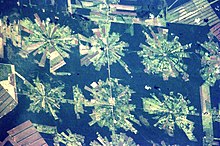Geography

Biodiversity hotspots are chiefly tropical regions that feature high concentrations of endemic species and, when all hotspots are combined, may contain over half of the world's terrestrial species. These hotspots are suffering from habitat loss and destruction. Most of the natural habitat on islands and in areas of high human population density has already been destroyed (WRI, 2003). Islands suffering extreme habitat destruction include New Zealand, Madagascar, the Philippines, and Japan. South and East Asia — especially China, India, Malaysia, Indonesia, and Japan — and many areas in West Africa have extremely dense human populations that allow little room for natural habitat. Marine areas close to highly populated coastal cities also face degradation of their coral reefs or other marine habitat. These areas include the eastern coasts of Asia and Africa, northern coasts of South America, and the Caribbean Sea and its associated islands.
Regions of unsustainable agriculture or unstable governments, which may go hand-in-hand, typically experience high rates of habitat destruction. Central America, Sub-Saharan Africa, and the Amazonian tropical rainforest areas of South America are the main regions with unsustainable agricultural practices and/or government mismanagement.
Areas of high agricultural output tend to have the highest extent of habitat destruction. In the U.S., less than 25% of native vegetation remains in many parts of the East and Midwest. Only 15% of land area remains unmodified by human activities in all of Europe.
Comments
Post a Comment